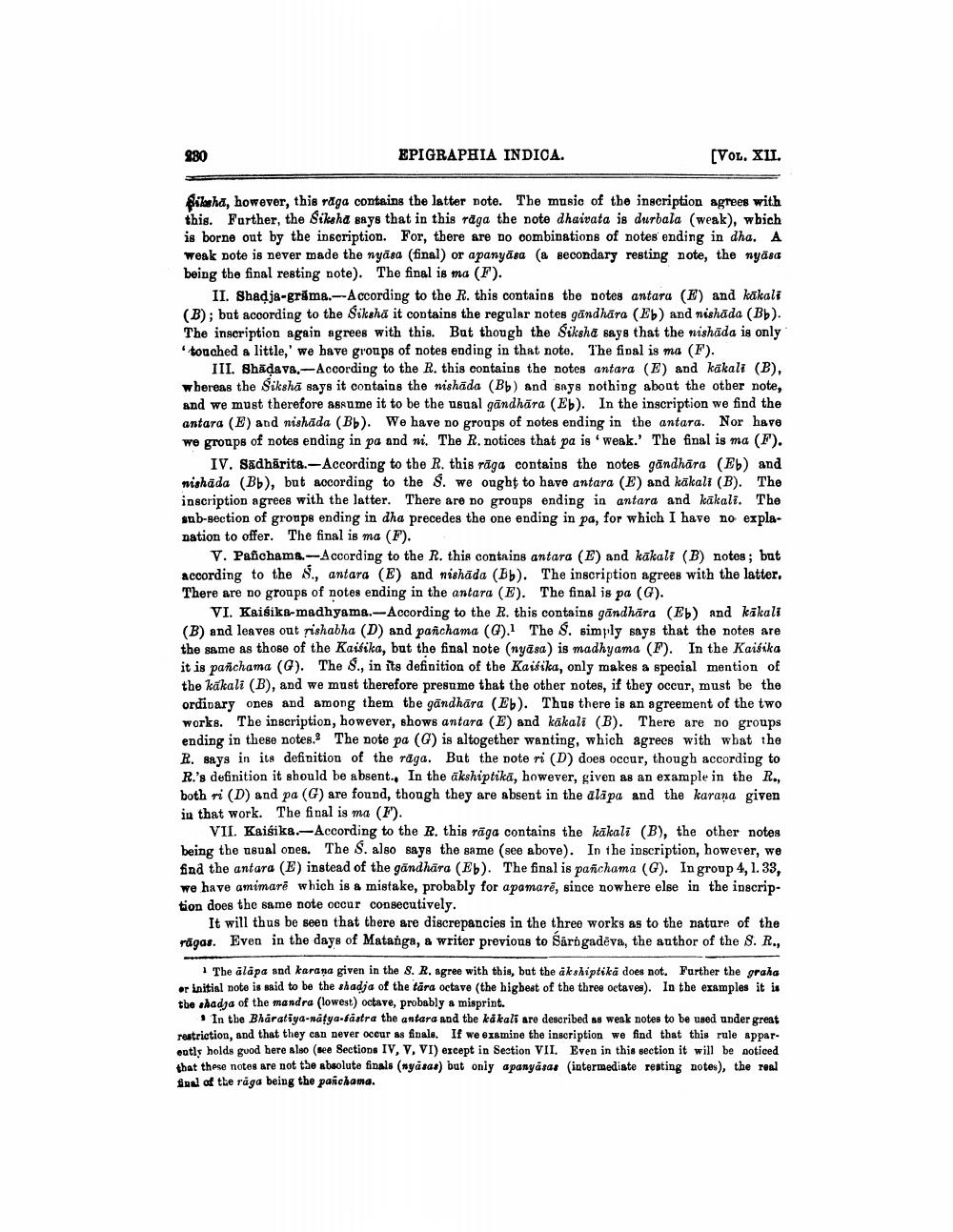________________
880
EPIGRAPHIA INDICA.
[VOL. XII.
Siksha, however, this raga contains the latter note. The music of the inscription agrees with this. Further, the Siksha says that in this rāga the note dhaivata is durbala (weak), which is borne out by the inscription. For, there are no combinations of notes' ending in dha. A weak pote is never made the nyāsa (final) or apanyāsa (a secondary resting note, the nyasa being the final resting note). The final is ma (F).
II. Shadja-grāma.-- According to the R. this contains the notes antara (E) and kakali (B); but according to the Siksha it contains the regular notes gāndhāra (Eb) and nishada (Bb). The inscription again agrees with this. But though the Siksha says that the nishāda is only touched a little,' we have groups of notes ending in that note. The fipal is ma (F).
III. Shādava.- According to the R. this contains the notes antara (E) and kūkali (B), whereas the Sikshā says it contains the nishāda (Bb) and says nothing about the other note, and we must therefore assume it to be the usual gāndhāra (Eb). In the inscription we find the antara (E) and nishada (Bb). We have no groups of notes ending in the antara. Nor have we groups of notes ending in pa and m. The R. notices that pa is weak.' The final is ma (F).
IV. Sadhārita.- According to the R. this rāga contains the notes gāndhāra (Eb) and nishāda (Bb), but according to the s. we ought to have antara (E) and kākali (B). The inscription agrees with the latter. There are no groups ending in antara and kakali. The sub-section of groups ending in dha precedes the one ending in pa, for which I have no explanation to offer. The final is ma (F).
V. Panchama.--According to the R. this contains antara (E) and kākali (B) notes; but according to the 8., antara (E) and mishāda (Bb). The inscription agrees with the latter, There are no groups of notes ending in the antara (E). The final is pa (G).
VI. Kaišika-madhyama.- According to the R. this contains gāndhāra (Eb) and kākali (B) and leaves out rishabha (D) and panchama (G). The $. simply says that the notes are the same as those of the Kaifika, but the final note (nyāsa) is madhyama (F). In the Kaifika it is pañchama (G). The 8., in its definition of the Kaifika, only makes a special mention of the kūkali (B), and we must therefore presume that the other notes, if they occur, must be the ordivary ones and among them the gāndhāra (Eb). Thus there is an agreement of the two works. The inscription, however, shows antara (E) and kākali (B). There are no groups ending in these notes. The note pa (G) is altogether wanting, which agrees with what the R. says in its definition of the räga. But the note ri (D) does occur, though according to R.'s definition it should be absent.. In the ākshiptikā, however, given as an example in the R., both ri (D) and pa (G) are found, though they are absent in the alapa and the karana given in that work. The final is ma (F).
VII. Kaisika.- According to the R. this rāga contains the kākali (B), the other notes being the usual ones. The S. also says the same (see above). In the inscription, however, we find the antara (E) instead of the gândhāra (Eb). The final is pañchama (G). In group 4, 1.33, We have amimarē which is & mistake, probably for a pamarē, since nowhere else in the inscription does the same note occur consecutively.
It will thus be seen that there are discrepancies in the three works as to the nature of the rāgas. Even in the days of Matanga, a writer previous to Särögadēva, the author of the 8. R.,
The alapa and karana given in the 8. R. agree with this, but the ak shipliká does not. Further the graha or initial note is said to be the shadja of the tāra octave (the higbest of the three octaves). In the examples it is the shadya of the mandra (lowest) octave, probably a misprint.
In the Bharatiya-natya-fästra the antara and the kåkali are described as weak notes to be used under great restriction, and that they can never occur as finals. If we examine the inscription we find that this rule apparentls holds good here also (see Sections IV, V, VI) except in Section VII. Even in this section it will be noticed that these notes are not the absolute finals (nyasas) but oniy apanyasas intermediate resting notes), the real final of the raga being the panchama.




